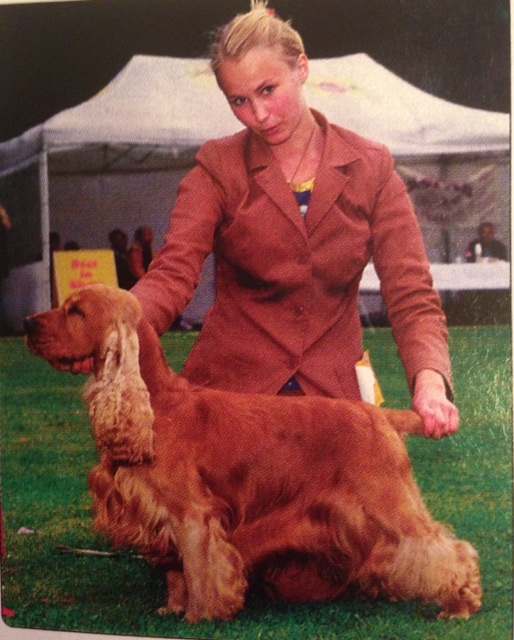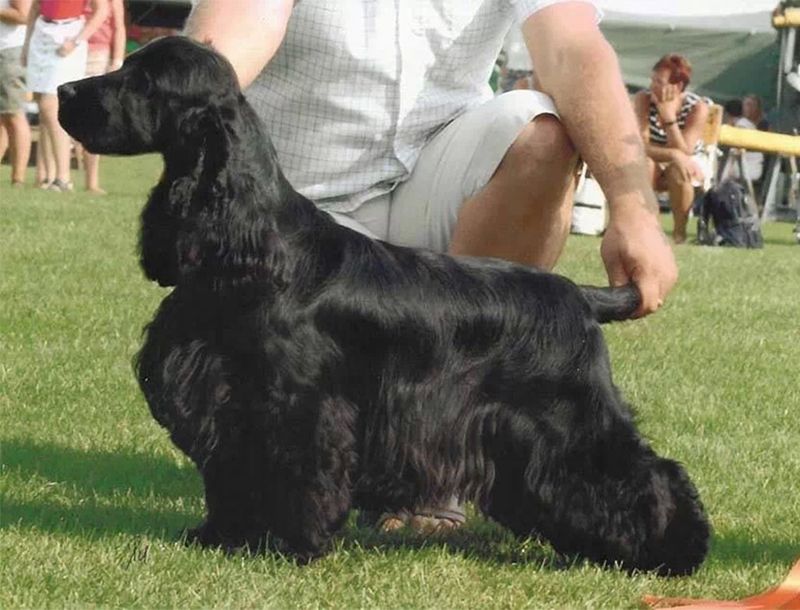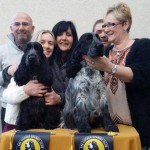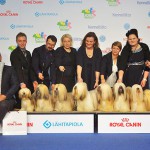Travis English Cocker Spaniels
Interview with Mr. Kari Haave • Interviewed by Jovana Danilovic
Published in Best in Show Annual 2016
BIS: First of all I would like to thank you for taking the time to do this interview. You have bred healthy and typey English Cocker Spaniels for generations now. How did you get started with English Cockers and why?
K.H.: I started learning as a young person from a Swedish breeder who had brought some high quality bitches with her from Stockholm to my native town of Bergen Norway where she lived with her new husband. She became a member of a very capable and creative group of breeders with different breeds such as Airedales, Sealyham Terriers, Giant Schnauzers and Kerry Blues .
I was eleven years old and helped with the dogs, learned to groom, and came along to listen to talks and discussions. Subsequently my parents allowed me to have a Cocker from her (early sixties) and later I made contacts in England, to be able to buy my first, red imported bitch from the Kavora kennels. She was No Ch Kavora Sarah Jane (late sixties) and was to be followed by many more from these kennels. She produced a champion and a certificate winner in her first litter, mated to Mr Geir Flyckt Pedersen’s Swedish import No Ch Örlidens Black Boots. This dog was of a very modern type, a result of mixing parties and solids, which was done with great success at that time. (This is also the case in the work over the last twenty or so years in Scandinavia) Although I initially really wanted a Shetland sheepdog, I was taken by the Cocker through my experience with my Swedish mentor and the more I learned the more I was impressed with this breed’s will to please and sensitive, loving and intelligent personality.

BIS: Which dog do you consider the foundation of your own breeding program?
K.H.: My early breeding was based on the Kavora lines in England. Ms. Pam Trotman was a good teacher and I was allowed to groom and go to shows with her as well as visit her breeder friends and listen to their ideas and thoughts about breeding , preparing, handling as well as politics. Ms Trotman was very organized and also very devoted to her dogs being single with no children. She did not allow any laziness and sloppiness- and forgetting to close a door or a gate was not accepted to say the least! One really learned about keeping a kennel. Every single dog was loved and cared for, though numbers could be around forty, in addition to several litters of different age. All veterans were also kept and cherished! Later I moved to Sweden and stopped breeding for a while. Many of my best dogs were acquired by new, skillful breeders, such as the Greentree kennels of the much-used Swedish dog photographer Lillemor Böös. Starting again, I had to acquire new lines and I wanted to add particolours, buying from Helenwood and Dewell kennels. Now I was lucky, being able to breed several all-breed group and BIS winners from a “klick” combination that I repeated several times. However, it was very difficult to find quality particolour
stud-dogs to match to my top winning bitches at the time. PRA and kidney failure had become a problem in several lines. I thought of early days mixed colour breeding and was extremely lucky to be able to buy Ch Leavenworth It’s a Pleasure, a red multiple group-winning dog with an amazing pedigree. He sired five different “Cocker of the year” winners in Sweden and Norway as well as a huge amount of top winning stock for different breeders. I inbred to him and was able to turn out one group winner after another, often combined with my blue roan bitches.
Therefore, no single dog has founded my stock, but rather a combination of unrelated lines brought together and concentrated through planned close breeding.
BIS: What do you consider your greatest achievement in breeding?
K.H.: I am proud that so many top winning cockers throughout the world still carry my prefix and key stud-dogs in their pedigrees, and that they have been truly sound and good tempered with correct attitude and coat texture.
I have bred Cockers from the early seventies so I take pride in the fact that I have managed to stay on the top level for 45 years. My newest English import won the European winners title this year. We won the dog certificate at the World Winners show and I have two new champions and another five on their way to their title, so I don’t feel burdened by my age just yet…
BIS: What do you consider your greatest achievement in showing?
K.H.: I have won more than a hundred gundog groups at all breed show level throughout Scandinavia, and have had several different dogs on Sweden’s top ten lists through the years. I have bred two World Winners, owned or bred two European Winners and numerous Scandinavian Winners. Also I have exported several dogs who won their titles in the US- one of them was even BIS at their main Spaniel Specialty. One of my blacks was runner up Dog of the Year in Sweden. However, it is the variety of different winners that I cherish the most, not a single dog’s achievement.
BIS: How many dogs do you have at home (living with you) and how many you co-own? How many litters approximately do you have each year?
K.H.: I always keep a variety of dogs to be able to compare the old with the new, to assess their quality and the progress or regression of my work. I now have about 20 at home. I love my old ones and love to keep them around. They tend to reach a high age and keep themselves in good vigor.
I like to run on several promising ones to compare their development. I also love good males and tend to keep more than I can really make use of in my breeding program. I co-own very few. Moreover, if I do so, it is with people I have a near relation to. It is very easy to fall out with friends in this business. Not worth it, I think.
The amount of litters differ. I own a busy grooming shop in Oslo and it is difficult to combine business with breeding sometimes. In addition, it is even difficult to get hold of suitable staff nowadays. The glamour of showing and handling seem to attract more youngsters than the basic work in a kennels. A pity, when I think about how I learned the tricks of the trade in my youth. However, I try to have two or three litters a year.
BIS: Please mention 2 or 3 English Cockers which are not owned, bred or shown by yourself, that you particularly admired, and tell us what you most admired about each.
K.H.: I am afraid that I have to go years back in time to find the dogs that really made me rave, but I am sure that this is quite normal. When you are young you might be easier to impress – or possibly, you are more open-minded. However, quality might even have been better during some of the golden periods of history- who can really tell?
Two blue roans immediately spring to mind, the bitch Sh Ch Wilholme Waltztime and the dog Sh Ch Courtmaster Mr Magic. The first, a dark blue- my favourite colour. This bitch taught me that a particolour could look solid colour in type and outline. And she made me want to start breeding parties. The second was a brilliant light blue that simply blew me away with his radiance and movement, winning BIS at London Cocker (if I remember correctly) before going to France.
In solids, it has been a long line of top blacks in England. Sh Ch Lochranza Newsprint. I just loved him and purchased a younger sister and a son. Sh Ch Canigou Cambrai. I had a super half-brother. Among others.
BIS: With how many kennels and who are the kennels you cobreed? How important was cooperation between breeders through the time?
K.H.: I don’t co-breed. I always do my own thing. Mostly I keep my own breeding material but I occasionally go out for new and additional lines. I always choose something I feel can link with mine in type and pedigree, no matter who owns them. In addition, I always let accomplished breeders use my dogs, as long as the bitches are well bred, sound and of a likeable type.
You have to create from your own sense of art and style within the standard, but you also need to share with others for the best of the breed.

BIS: And are you mentoring someone at the moment?
K.H.: I had the opportunity to have several Swedish, Finnish and above all English breeders to confer with and learn from. And I always like to share knowledge and advice with new people if they want my opinion.
BIS: Tell us please the main characteristic you admire in the breed? What are your goals in the breeding program?
K.H.: I love the way Cockers are so eager to please and understand their owner. They can read ones state of mind, and are great companions, devoted to their chosen people. You have to treat them with love and respect or they will be very frustrated and unhappy. They do need both time and attention.
My goal has always been to create a beautiful, true-to-standard dog with powerful gait and charisma, who can carry himself naturally without having to be over-handled and strung up to show himself up. I just hate unnatural handling and harsh treatment of dogs, and the Cocker is a sensitive dog who needs understanding and kindness to make the most of himself. This is very important to me. In addition, I do not want a high strung, overly active dog. They should make easy and relaxed pets at home, yet show the typical working ability and energy in the fields and woodland as well as in the show ring. Will -to -please is the main characteristic of the breed.
I also want easy births, good, healthy mothers and clever stud dogs who are sensible to keep along with bitches in season. Moreover, they should never fight or be individual leaders, the owner is the leader of the gundog pack and the dogs should naturally pay attention to what we wish.
BIS: In which ways has the breed changed over time since you first got involved with the breed?
K.H.: Not much overall. Perhaps the solids’ temperaments are better, the soundness regarding eyes and hips are better, the compactness and head types were better before, but toplines and tailsets might be overall better now. Fronts, especially set on of shoulders were probably better when I started.
Movement is somewhat different now; the dogs are trained and handled differently and are looking flashier in a way. Sometimes I find this a bit overdone. But this is a discussion in its own right. And my viewpoint might well be influenced by my age…
BIS: How do you define “type”?
K.H.: Type is difficult to define with few words. To me it is the quintessence of each breed- the characteristics that make a dog different from any other breed. The dog should fulfill the standard’s acquirements of course, but type is something beyond this. It lies in the expression, how the dog handles himself, his outline and balance, how he moves, how naturally he stands on his legs. It is the sum of all parts, coat and colour included. It is a stamp of quality that is difficult to describe, but which is understandable to those who really know their thing. Type can differ slightly within the standards of course, but you should be able to recognize a typey dog when you see one. Cockers should be a combination of power, compactness, yet nobility. It should be sturdy but never loose or coarse. It is the true balance of all these characteristics that is the art.
BIS: Every breed has some common problems. Which is the most common problem in your variety seen from a breeder’s point of view?
K.H.: This is basically a sound and healthy breed. We have to observe over-groomed and heavy coats, which is flashy but rather untypical. This can be a problem for the pet owner- and it makes people clip them down to the skin, so ugly, unhealthy and unnecessary.
Judges have to look under the coat- not just fall for expert presentation as many do today.
We have fewer outstanding males at the moment- but are in the position of seeking new bloodlines throughout the world in a greater extent than before.
Newer breeders sometimes seem to have less knowledge of basic anatomy than earlier, spending more time and effort on coat care and handling.
The structural faults are still present- but are sometimes neglected due to” bling of the ring”. Otherwise, the breed is very popular as family dogs here, a very good proof of the true qualities. On the other hand, fewer dogs are being shown, and fewer breeders keep a number of dogs- many potential stud dogs “disappear” from our breeding programs due to this.
BIS: Please name few traits you look for in the ring in order of importance.
K.H.: I look for great movement, noble carriage, compactness, merry temperament with will-to-please attitude, balanced outline and tail carriage and the correct coat quality. I don’t care about colour or markings as long as they are within the standard. There has been a trait of smaller specimen in a period of time. I also look for the correct size. This is a working dog- not an “ornament”.
BIS: What, if anything, do you feel non-breeder judges get wrong about the breed?
K.H.: This you can read from the answers above! It surprises me how little emphasis some lay in the structure and balance of dogs and how overly important presentation and handling have become. Not good for the future of breeding dogs.
It must be a balanced combination. Therefore, it is always useful to watch the breed in England. The English are still essentially stockbreeders I feel.
BIS: If you were in charge of everything regarding the dog shows what change would you make first?
K.H.: I would take away some of the fancy Hollywood-show feeling and bring it back to “Crufts- style”- honest, knowledgeable, stylish events with respect for the dog’s feelings and the breeders and judges know-how in the ring. Turn down the music and the sometimes overdone extra entertainment. The dogs themselves should easily fill this role themselves.
The judges must judge there and then, to their own conviction and ability and be able to bring this fact across to the public. Only then, will this sport survive and keep up the respect of the fanciers.
BIS: What would be the most important single piece of advice you would give to all serious young breeders?
K.H.: Learn everything from the bottom. Make use of different longstanding breeders, it is not about putting on a show suit and groom your dog all night before a show. It is about knowledge, care, and even more knowledge. You must never stop learning. Appreciate the generations of hard work that lies behind what you have in your hands.
Finally, be aware of your responsibilities!



